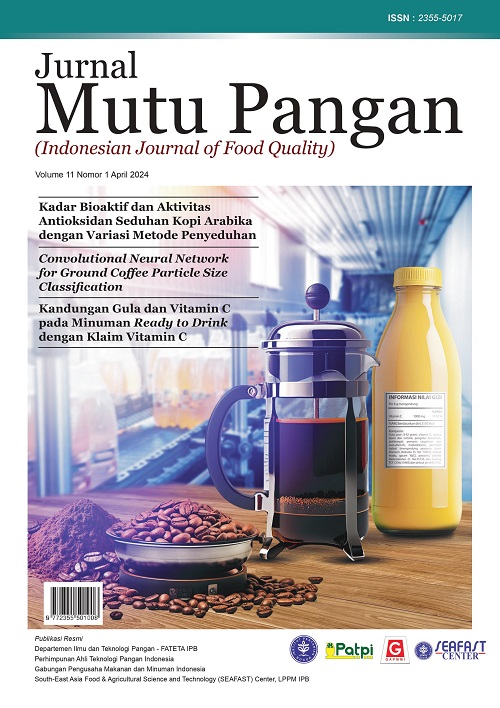Convolutional Neural Network for Ground Coffee Particle Size Classification
Abstract
Indonesia is the fourth largest coffee-producing country in the world. The popularity of coffee is increasing due to people's curiosity about the origin of coffee, from harvest to the hot cup of coffee on their table. This coffee culture drives innovators to develop coffee processing technology. Currently, there are tens of different coffee brewing methods available, each with their own unique flavor characteristics. The particle size of coffee beans is the basis for brewing coffee using specific methods. Identifying the particle size and calibrating tools to grind coffee requires special skills, expertise, experience, and a time-consuming process. Therefore, this study aims to develop a tool to classify the particle size of ground coffee based on computer vision. The object of this research is ground coffee with various particle sizes, which are acquired through imagery and will be classified using Convolutional Neural Network to provide recommendations for brewing coffee according to the particle size of the ground coffee. To build the classification model, the architectures were trained by full learning and transfer learning using VGG-19, MobileNet, and InceptionV3. The results showed that the classification model using the Convolutional Neural Network using the cellphone camera dataset achieved an accuracy value of 0.80. Meanwhile, with the microscope dataset, the model's accuracy only reached 0.58. Therefore, the classification model using the cellphone dataset is feasible to be implemented to determine the particle size.
Downloads
References
Arboleda ER, Fajardo AC, Medina RP. 2018. Classification of coffee bean species using image processing, artificial neural network and K nearest neighbors. In 2018 IEEE International Conference on Innovative Research and Development (ICIRD), pp. 1-5. IEEE. DOI: 10.1109/ICIRD.2018.8376326.
[BPS] Badan Pusat Statistik. 2017. Statistik Kopi Indonesia. https://www.bps.go.id/publication/2018/12/20/71e7ada61b13e59be0b1bf80/statistik-kopi-indonesia-2017.html [Accessed on 17 September 2022].
Bjerrum EJ, Glahder M, Skov T. 2017. Data augmen-tation of spectral data for convolutional neural network (CNN) based deep chemometrics. arXiv: 1710.01927. DOI: 10.48550/arXiv.1710.01927.
Chakravartula SSN, Moscetti R, Bedini G, Nardella M, Massantini R. 2022. Use of convolutional neural network (CNN) combined with FT-NIR spectroscopy to predict food adulteration: A case study on coffee. Food Control 135: 108816. DOI: 10.1016/j.foodcont.2022.108816.
Chi P, Zhang Z, Liang R, Cheng C, Chen S. 2020. A CNN recognition method for early stage of 10 kV single core cable based on sheath current. Electr Power Syst Res 184: 106292. DOI: 10.1016/j.epsr.2020.106292.
Choi JY, Ro YM, Plataniotis KN. 2011. A comparative study of preprocessing mismatch effects in color image based face recognition. Pattern Recognit 44(2): 412-430. DOI: 10.1016/j.patcog.2010.08.020.
Chollet F. 2015. Keras open-Source Neural-Network Library Written in Python. https://github.com/fchollet/keras [Accessed on 9 August 2022].
Delta Coffee Roaster. 2020. Ukuran Gilingan Kopi. https://tamandelta.com/ukuran-gilingan-kopi/ [Accessed on 26 July 2022].
García M, Candelo-Becerra JE, Hoyos FE. 2019. Quality and defect inspection of green coffee beans using a computer vision system. Appl Sci 9(19): 4195. DOI: 10.3390/app9194195.
Greene M. 2019. A Beginners Guide to Immersion Coffee Brewing. https://prima-coffee.com/learn/article/coffee-basics/a-beginners-guide-immersion-coffee-brewing/29121 [Accessed on 15 September 2022].
Howard AG, Zhu M, Chen B, Kalenichenko D, Wang W, Weyand T, Andreetto M, Adam H 2017. Mobilenets: Efficient convolutional neural networks for mobile vision applications. arXiv:1704.04861.
Ikechukwu AV, Murali S, Deepu R, Shivamurthy RC. 2021. ResNet-50 vs VGG-19 vs training from scratch: A comparative analysis of the segmentation and classification of Pneumonia from chest X-ray images. Glob Transit Proc 2(2): 375-381. DOI: 10.1016/j.gltp.2021.08.027.
Jahandad, Sam SM, Kamardin K, Sjarif NNA, Mohamed N. 2019. Offline signature verification using deep learning convolutional neural network (CNN) architectures GoogLeNet inception-v1 and inception-v3. Procedia Comput Sci 161(2019): 475-483. DOI: 10.1016/j.procs.2019.11.147.
Karpathy A. 2016. Cs231n convolutional neural networks for visual recognition. https://cs231n.github.io/ [Accessed on 20 September 2022].
[Kementan] Kementerian Pertanian RI. 2018. Konsumsi Kopi Nasional. https://databoks.katadata.co.id/datapublish/2018/07/31/2021-konsumsi-kopi-indonesia-diprediksi-mencapai-370-ribu-ton [Accessed on 17 September 2022].
Khamitova G, Angeloni S, Borsetta G, Xiao J, Maggi F, Sagratini G, Vittori S, Caprioli G. 2020. Optimization of espresso coffee extraction through variation of particle sizes, perforated disk height and filter basket aimed at lowering the amount of ground coffee used. Food Chem 314: 126220. DOI: 10.1016/j.foodchem.2020.126220.
LeCun Y, Bengio Y, Hinton G. 2015. Deep learning. Nature 521(7553): 436-444. DOI: 10.1038/nature14539.
Leme DS, da Silva SA, Barbosa BHG, Borém FM, Pereira RGFA. 2019. Recognition of coffee roasting degree using a computer vision system. Comput Electron Agric 156: 312-317. DOI: 10.1016/j.compag.2018.11.029.
Mahmud KH, Adiwijaya, Al Faraby S. 2019. Klasifikasi Citra Multi-Kelas Menggunakan Convolutional Neural Network. 2127-2136. eProceedings of Engineering, Telkom University, Bandung.
Musika YA. 2017. Jenis Coffee Grind Size dan Metode Seduhannya, Otten Coffee. https://ottencoffee.co.id/majalah/jenis-coffee-grind-size-dan-metode-seduhannya [Accessed on 25 July 2022].
Pandey RK, Kumar A, Mandal A. 2022. A robust deep structured prediction model for petroleum reservoir characterization using pressure transient test data. Pet Res 7(2): 204-219. DOI: 10.1016/j.ptlrs.2021.09.003.
Pinto C, Furukawa J, Fukai H, Tamura S. 2017. Classification of Green coffee bean images basec on defect types using convolutional neural network (CNN). In 2017 International Conference on Advanced Informatics, Concepts, Theory, and Applications (ICAICTA), Bali, Indonesia, pp. 1-5. IEEE. DOI: 10.1109/ICAICTA.2017.8090980.
Rodríguez JP, Corrales DC, Aubertot JN, Corrales JC. 2020. A computer vision system for automatic cherry beans detection on coffee trees. Pattern Recognit Lett 136(2020): 142-153. DOI: 10.1016/j.patrec.2020.05.034.
Saha S. 2018. A comprehensive guide to convolutional neural network. https://towardsdatascience.com/a-comprehensive-guide-to-convolutional-neural-networks-the-eli5-way-3bd2b1164a53 [Accessed on 20 September 2022].
Santos FFLD, Rosas JTF, Martins RN, Araújo GDM, Viana LDA, Gonçalves JDP. 2020. Quality assessment of coffee beans through computer vision and machine learning algorithms. Coffee Sci 15(2020): e151752. DOI: 10.25186/.v15i.1752.
Simonyan K, Zisserman A. 2014. Very deep convolutional networks for large-scale image recognition. arXiv:1409.1556.
Unal Y, Taspinar YS, Cinar I, Kursun R, Koklu M. 2022. Application of pre-trained deep convolutional neural networks for coffee beans species detection. Food Anal Methods 15(12): 3232-3243. DOI: 10.1007/s12161-022-02362-8.
Wandell BA, El Gamal A, Girod B. 2002. Common principles of image acquisition systems and biological vision. Proceedings of the IEEE 90(1): 5-17. DOI: 10.1109/5.982401.
Wijaya AA, Prayudi Y. 2010. Implementasi Visi Komputer dan Segmentasi Citra untuk Klasifikasi Bobot Telur Ayam Ras. Seminar Nasional Aplikasi Teknologi Informasi (SNATI). G1-G5. Yogyakarta, 19 Juni 2010.

















